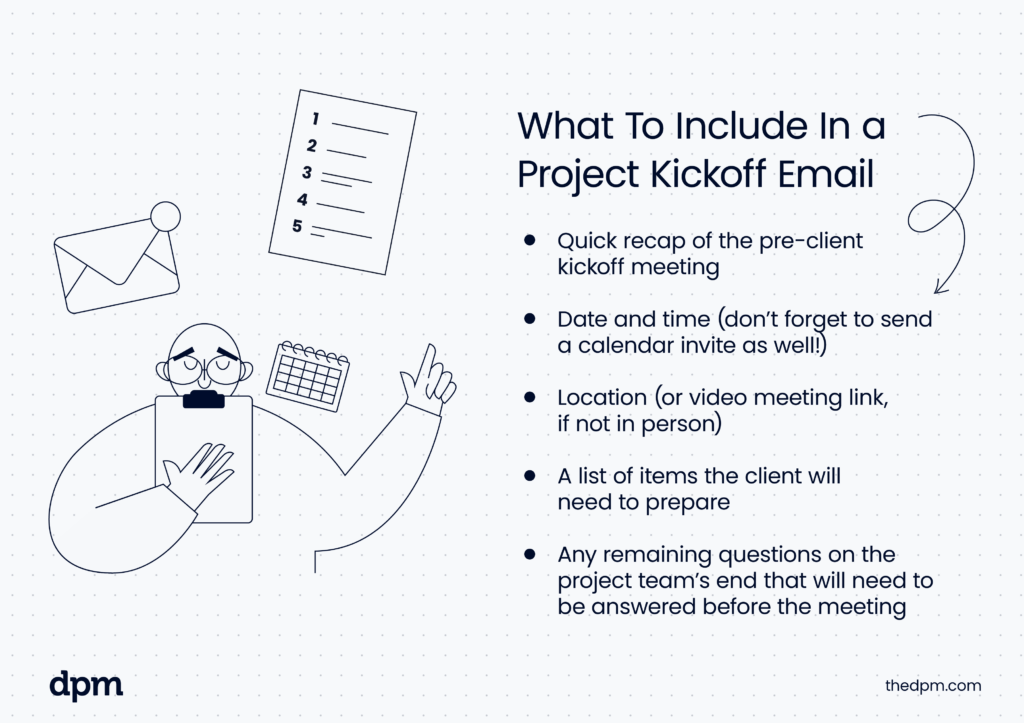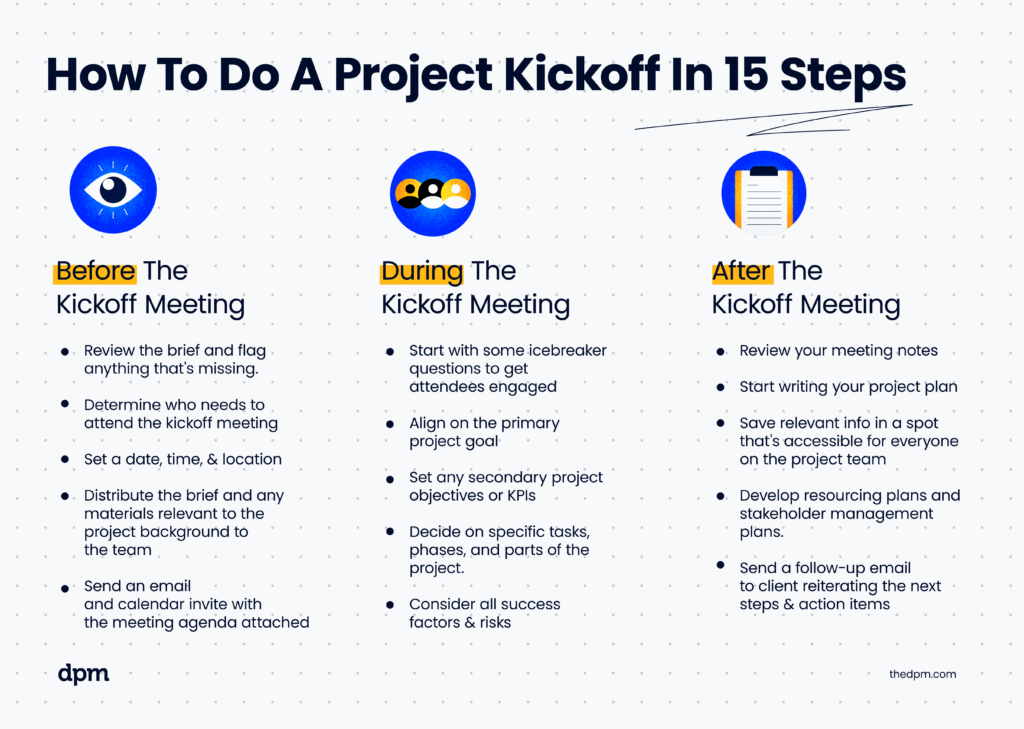New projects can sometimes start off a bit wonky because we dive straight into the project without getting to know the client or the tacit, latent, and informal requirements we need to fully understand what needs to be done to succeed.
Fundamentally, it’s about alignment: the project kickoff is an opportunity to establish common goals and the purpose of the work, whether the project is external or an internal one.
What Is A Project Kickoff?
The project kickoff is part of the project initiation phase of the project life cycle. It’s a critical project management activity that involves preparing the project team members and the client team on expectations, communication, and collaboration for the project.
It informs the project planning phase of the project, and also allows your team and the client to iron out and finalize details such as project timeline, project management methodology, success measurement, and more.
Most kickoffs require a series of meetings, both internal and client-side. If your project doesn’t have a client, kickoffs are still necessary and should involve all project stakeholders and project sponsors.
What Is A Project Kickoff Meeting?
You can think of the project kickoff meeting as having two parts: a pre-client kickoff meeting, and a client kickoff meeting.
Here’s a little secret: you don’t want your first meeting with the client or key stakeholder to be the official kickoff meeting with the full client team and full project team. Instead, hold a pre-client kickoff meeting first. This is worthwhile for a few reasons:
- You’ll be able to nail down the project approval process without other attendees chiming in and claiming they need to be involved. If you speak with the client one-on-one, you’ll be able keep the project approval process streamlined.
- You’ll be able to confirm the statement of work and project scope. If you leave this discussion to the official kickoff meeting with the full client team, they’ll inevitably try to include or exclude parts of the scope or deliverables that were already previously agreed upon, forcing you to change your project plan.
- You’ll be able to establish a positive relationship with the client right off the bat, setting the tone for a good rapport and working relationship as the project progresses.
- You’ll be able to iron out a few other important details in advance, such as collaboration tools, what assets will be needed, and the kickoff meeting agenda.
What Is The Purpose of a Kickoff Meeting?
As mentioned, the purpose of a project kickoff meeting is to get alignment so the team can get to work on the project. There's multiple purposes to the meeting, all of which contribute to this overall goal of alignment.

- Introduce the team
- Create a shared understanding of the project background
- Ensure alignment on what a successful project looks like
- Get agreement on what exactly needs to be done
- Decide on how to work together effectively
What To Cover In The Kickoff Meeting
There's a lot that you'll need to get through in your project kickoff meeting, so having a proper agenda is a must. Here's what you'll need to cover (use this as a blueprint for your agenda):

- Introductions: Who are the team members on the project and what are their roles?
- Project background information: How does this brief fit into the broader strategy and any other projects that the business or client is working on?
- Project briefing: What's the business problem and the customer need?
- Project success: How will we know if we've been successful? What KPIs or metrics will we use?
- Project management: Review the timeline, project milestones, project deliverables, risk, roles, project status reporting, estimate, and change management
- Any other business: What haven't we discussed that we should?
- Next steps: What are the next steps to keep the project moving?

It's also a good idea to have a project kickoff meeting presentation, in the form of a slide deck, to accompany your agenda.
Project Kickoff Email
Once you’ve met with the client for a pre-kickoff and prepped your agenda for the client kickoff meeting, you’ll need to send out that all-important project kickoff email announcing when and where the meeting will be.
During the pre-client kickoff, it’s a good idea to get an idea of the client’s schedule for the kickoff meeting. Every project manager has their own strategy for scheduling meetings, but getting an idea beforehand doesn’t hurt, as you can use this to your advantage in your email.
Here’s a quick overview of what you should be including in your project kickoff announcement email:

- Quick recap of the pre-client kickoff meeting
- Date and time (don’t forget to send a calendar invite as well!)
- Location (or video meeting link, if not in person)
- A list of items the client will need to prepare
- Any remaining questions on the project team’s end that will need to be answered before the meeting
Try to send out the project kickoff email in advance, to ensure you leave the client with enough time to prepare the content and items that you asked for. Also, keep it fairly high-level—you don’t want to overwhelm the client with a lengthy email (they might not even read it!).
Don’t forget to follow-up again after the kickoff meeting with an email. This one should include:
- Recap of the kickoff meeting
- List of next steps and due dates
- List of any remaining questions or concerns on your end or on the client’s end
How To Do A Project Kickoff In 15 Steps
Here's what to do before, during, and after the project kickoff meeting to make sure you have a successful project kickoff.

Before The Kickoff Meeting
- Review the brief and flag anything that's missing.
- Determine who needs to attend the kickoff meeting
- Set a date, time, & location
- Distribute the brief and any materials relevant to the project background to the team
- Send an email and calendar invite with the meeting agenda attached
During The Kickoff Meeting
- Start with some icebreaker questions to get attendees engaged
- Align on the primary project goal
- Set any secondary project objectives or KPIs
- Decide on specific tasks, phases, and parts of the project
- Consider all success factors & risks
After The Kickoff Meeting
- Review your meeting notes
- Start writing your project plan
- Save relevant info in a spot that's accessible for everyone on the project team
- Develop resourcing plans and stakeholder management plans
- Send a follow-up email to client reiterating the next steps & action items
Other Types Of Project Kickoffs
There are a couple of other types of kickoffs and kickoff meetings that you might have, aside from the usual client kickoff meeting.
Internal Project Kickoffs
You might think of an internal project kickoff meeting as being a quick 10-minute chat with the internal team in the meeting room just before the client walks in. If you’ve been managing projects for a while, you’ll know that this is not an ideal scenario.
The purpose of an internal project kickoff is to bring the project team up to speed on an external project and properly prepare them for the official kickoff meeting with the client. (For internal projects, you'd just call the internal kickoff the official project kickoff meeting.)
As the project manager, your job is to educate them, bring the team together, set expectations for the project, and ensure a clear understanding of the project among all team members (and yourself!).
There’s a lot that goes into an internal project kickoff meeting. You’ll need to prepare an agenda, gather information and details about both the client and the project, and put together some initial thoughts on collaboration, communication, teamwork, and more for the team to discuss.
Read more about what to do before, during, and after your internal kickoff here.

Life too short for reading?
Get all our action-ready project kickoff templates and a crash course for just $49 USD.
Agile Project Kickoffs
Many agile enthusiasts question the value of project kickoffs for projects conducted using agile methodologies. But if done correctly, agile project kickoffs can add a lot of value and provide clarity to the team for projects that are using agile methodologies such as Scrum.
The general purpose of an agile project kickoff is the same as the purpose of a project kickoff:
- Introduce the team
- Understand the project background and the purpose of the project
- Understand what a successful project is
- Understand what needs to be done
- Agree on how to work together
But trying to conduct an agile project kickoff in the exact same way that you would a regular project kickoff won’t be valuable. You’ll need to adjust your regular project kickoff meeting agenda slightly to account for this.
However, there are some additional reasons why you might hold an agile project kickoff:
- Get a sense of how the team likes to work in terms of workflow, and what the team members’ strengths and weaknesses are. Most agile teams don’t know exactly what they’ll be working on for a project until the sprint has been planned, so having a sense of likes, dislikes, strengths, and weaknesses will help with assigning work when the time comes.
- Decide on sprint length, limits to work-in-progress, defining 'done' for deliverables and specific tasks, and other team norms.
- Decide on what tools will be used for managing communication (ex. Slack) and tracking bugs (ex. Jira), and what project management software you'll use (ex. Microsoft Project).
What’s Next?
Displaying your leadership skills is an important part of doing a project kickoff well. You need to get both the client and the team on your side, which you can't do without being a good leader.
For more on project kickoffs and other key project management processes, subscribe to The Digital Project Manager newsletter.


